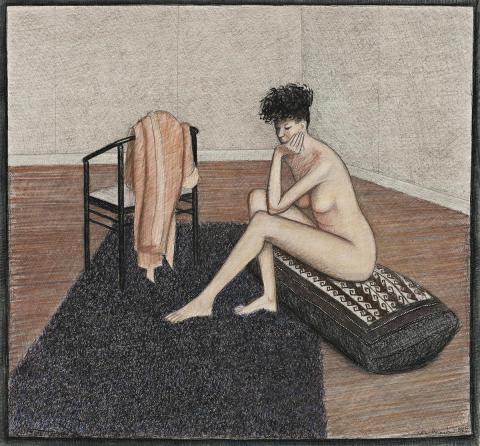NUDE WITH PURPLE RUG, 1985
JOHN BRACK
watercolour, pastel and crayon on paper
75.0 x 80.5 cm
signed and dated lower right: John Brack 1985
Rex Irwin Art Dealer, Sydney (label attached verso)
The Estate of the late James O. Fairfax AC, New South Wales and Bridgestar Pty Ltd, Sydney, acquired from the above in 1993
John Brack: Recent Painting, Tolarno Galleries, Melbourne, 23 May – 13 June 1987
John Brack Paintings and Drawings, DC-Art, Sydney, 19 September – 15 October 1988
Works on Paper, Rex Irwin Art Dealer, Sydney, 23 March – 8 April 1993, cat. 7
The Nude in the Art of John Brack, McClelland Gallery + Sculpture Park, Victoria, 17 December 2006 – 25 March 2007, cat. 35
Grishin, S., The Art of John Brack, Oxford University Press, Melbourne, 1990, vol. II, cat. P295, pp. 73, 244 (illus.)
John Brack was an acute observer of the world around him. While he is probably best known for his now iconic depictions of suburban life as it was lived in Australia during the 1950s, what most interested him and motivated his creativity was the desire to understand and illuminate people and the human condition.1 The history of art remained an essential touchstone and important source of inspiration for Brack throughout his career. Alongside references to significant works of art – from Boucher, to Seurat and Manet – in his paintings, he also worked within traditional genres of Western art including the still-life, portraiture and the nude.
Brack’s first sustained focus on the theme of the nude occurred in the mid-1950s when he hired a life model and realising that ‘there is absolutely nothing whatsoever erotic in an artist’s model unclothed in a suburban empty room’2, attempted to de-eroticise his depictions and subvert one of the primary expectations of the genre. The nude returned as a major subject within his oeuvre during the 1970s and 80s and while a certain sensuality and pleasure in depicting the female form is evident, in these works he also attempted to reveal things that are not visible to the naked eye. Helen Brack has described the recurring focus on the nude as ‘John’s need for discipline in seeing and depicting, and his constant effort to define how women are’.3 Brack’s own statement further clarifies his ambition: ‘When I paint a woman … I am not interested in how she looks sitting in the studio, but in how she looks at all times, in all lights, what she looked like before and what she is going to look like, what she thinks, hopes, believes, and dreams. The way the light falls and casts its shadows is merely … a hindrance unless it helps me to show these things.’4
Combining watercolour with pastel and crayon, Nude with Purple Rug, 1985 brings together many of the characteristic elements of Brack’s late nudes: a spare, unadorned room; selected props – here a chair with the model’s robe draped over it, a rug and patterned cushion (taking the place of the Persian carpets he often used) – and the model, her gaze downcast, seated in a thoughtful, reflective pose with her head resting in her hand. Strong diagonals lead the eye from the base of the picture towards the centre where the texture of the rug and the model’s curly hair contrast with the crisp lines that define the walls and floorboards. In turn, these are echoed by the outlines of the chair, rug and cushion, as well as the model’s long angular limbs – making this drawing a study in texture and form. A talented draughtsman, Brack enjoyed the formal challenges of drawing from life and works such as this attest to his skills of observation and ability to describe the nuances and idiosyncrasies of his subject, as well as his mastery of pictorial composition.
1. Grant, K., John Brack, exhibition catalogue, National Gallery of Victoria, Melbourne, 2009, p. 87
2. Brack, J. interviewed in Australian Contemporary Art Archive, no. 1, Deakin University Media Production, 1980, transcript, p. 3
3. Brack, H., ‘This Oeuvre – The Work Itself’, Grant, K., op. cit., p. 16
4. Brack, J., quoted in Grishin, S., ‘The nudes of John Brack’, John Brack (1920-1999): A Tribute Exhibition, exhibition catalogue, Rex Irwin, Sydney, 1999, unpaginated
KIRSTY GRANT
Former Director of Heide Museum of Modern Art
Former Senior Curator, National Gallery of Victoria
